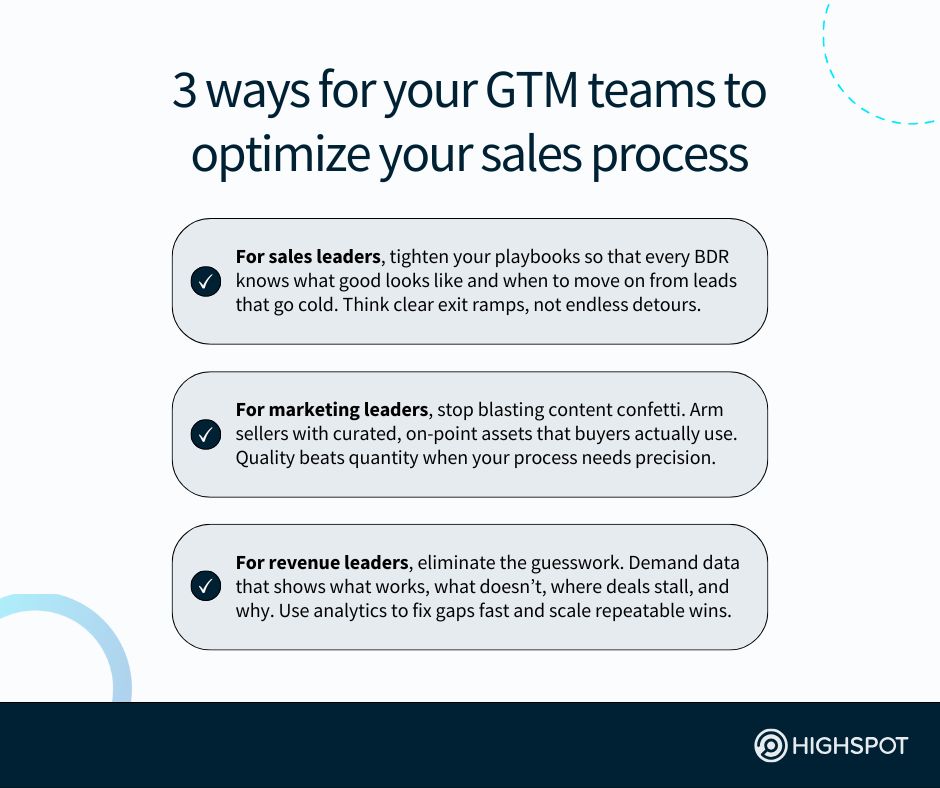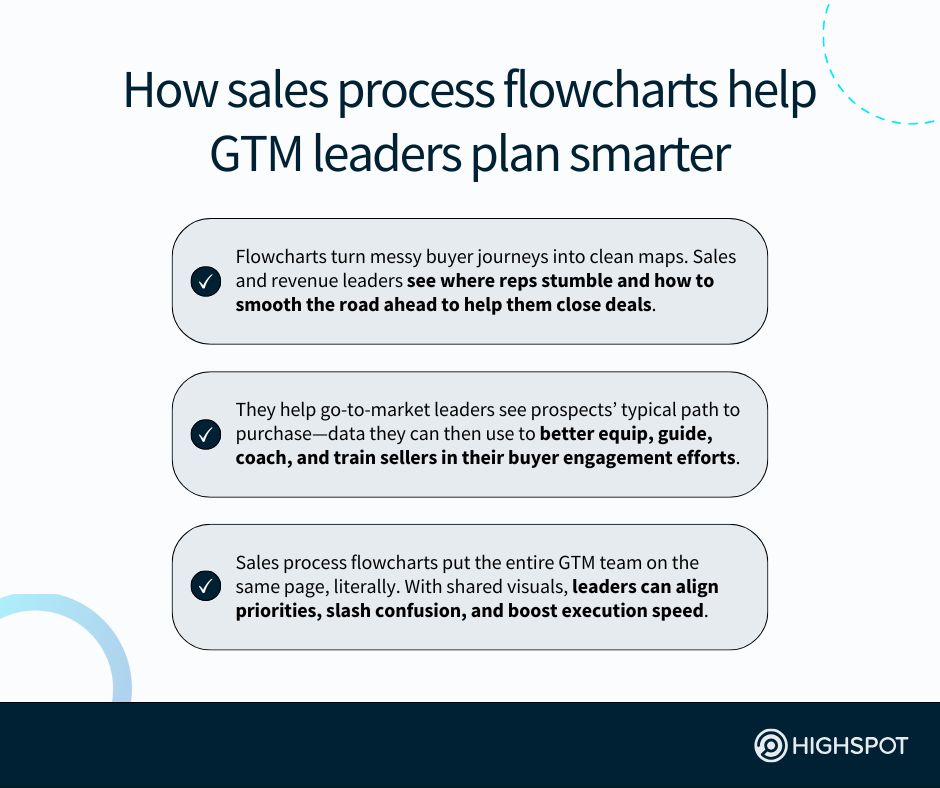Key Takeaways
- Think of your sales process as a repeatable playbook: from prospecting, to closing, to upselling. It keeps tasks organised, helps new reps ramp up faster, builds stronger relationships, and improves forecasting.
- Tailor your sales process to your B2B buyer’s journey. Layer in AI-powered and automation tools and content at each stage of the sales cycle, pilot the flow with top sales reps, then train widely once it works.
- A sales process shouldn’t be set in stone. Track key metrics like conversion rates, cycle length, and satisfaction. Listen to reps and customers, then tweak or overhaul stages based on what’s actually working—or not.
You’ve optimised your B2B sales process and related rep workflows.
More to the point, you’ve fine-tuned your sales technology stack to give your sellers the tools they need to succeed. What’s more, you’ve built out (and continually updated) a proven sales playbook to help BDRS understand how to put themselves in potential customers’ shoes to recognise their pain points.
And yet, despite your best efforts, pipeline issues still arise. Reps miss the mark on discovery calls. Messaging drifts. Enablement feels reactive, not proactive. Suddenly, it’s Q3, and you’re wondering, “How did we fall out of rhythm again?”
Sound familiar?
This is the game every go-to-market leader is playing in 2026: keeping a defined and structured sales process aligned with real-world selling chaos.
Modern sales is no longer linear. It’s a shape-shifter that, without the right tech and data infrastructure and agility and flexibility to adjust sales processes, can be difficult to predict and plan for. What worked six months ago for your business might now stall deals, misfire with buyers, or overwhelm sellers.
That’s why your sales team needs an adaptable, insight-fueled approach where:
- Each and every sales rep understands what good looks like and how to repeat it
- You can equip, guide, train, and coach your team for selling moments that matter
- Sellers can convert qualified leads consistently, without losing the human touch
- You can turn rich insights into winning actions at scale, not next-quarter regrets
It’s this approach that will ultimately address your go-to-market performance gaps.
Simply put, a modern sales process is now all about empowering your sales team with the solutions, insights, and habits that drive results throughout the buying process. It’s about dialing in the right mix of GTM enablement, sales automation, and AI tools so reps can show up smart, stay sharp, and keep closing deals.
At the end of the day, selling is your organisation’s growth engine. And when you have a highly effective sales process that hums, so does your business. You’re not ‘just a vendor’ in your prospects’ eyes. You’re the must-have solution they’ve been looking for for some time and the partner they need to grow.
So, let’s break it down: the new anatomy of a structured sales process that drives clarity, boosts win rates, and helps you optimise every step of your go-to-market motion. This is your 2026 blueprint for GTM enablement that actually works.

What is a sales process?
The sales process is the repeatable set of steps your reps follow to turn leads who pass the qualifying stage into new customers. To build a sales process that delivers results, you need clear stages, aligned tools, and measurable outcomes.
Many go-to-market functions today create a sales process flowchart to visualise rep actions, buyers’ decision-making process, and key GTM team handoffs.
A strong sales process helps both sales leaders and managers coach more effectively and prioritise their team’s time. It also relies on data to give revenue and sales operations leaders actionable insight into what is and isn’t working, in terms of influencing prospects’ buying decisions and helping reps close deals.
Input from key marketing team stakeholders when developing a sales process helps inform lead generation approaches, brand and product messaging, enablement content, and integrated campaigns so they can support the entire process.
Implementing a defined selling process that aligns with your sales strategy and sales methodology and accounts for your company’s business objectives helps guide how reps identify leads, engage with buyers, and qualify opportunities.
| Sales process stage | What it involves | Tools needed to execute |
|---|---|---|
| Prospect sourcing and identification | Sales reps proactively connect with and capture new prospects by working with marketing using inbound and outbound tactics, then prioritising those most likely to convert into qualified leads. | CRM (store and track leads), Marketing automation (generate demand campaigns), Sales enablement platform (surface targeted content for outreach) |
| Lead qualification and outreach | Sellers assess prospect fit by verifying need, budget, authority, and timeline (BANT), ensuring only realistic business opportunities enter the pipeline and receive valuable sales engagement. | CRM (track qualification criteria), Sales engagement solution (automate outreach sequences), Conversation intelligence tool (capture conversations for review) |
| Account and stakeholder research | Reps ID decision-makers and influencers, analyse organisational structure, and gather intelligence to personalise engagement and anticipate potential objections before deeper interactions begin. | LinkedIn Sales Navigator (map org charts), Competitive intelligence platform (track company insights), CRM (centralise account and contact data) |
| First-touch buyer engagement | The first live interaction between BDRs and buyers aims to build credibility quickly, establish rapport, and spark meaningful dialogue that validates interest and aligns to stakeholder challenges. | Sales engagement solution (manage outreach cadence), CRM (track interactions), Video conferencing tool (conduct initial calls) |
| Objection-handling and reframing | Sales reps address leads’ concerns directly, reframe objections into opportunities, and demonstrate value by connecting customer needs with specific solutions that resolve pain points. | Sales enablement platform (deliver objection-handling plays), Call intelligence software (analyse buyer concerns), CRM (log objections and outcomes) |
| Data-driven follow-up strategy | Sellers use real-time buyer engagement insights and pipeline performance data to determine when and how to re-engage, ensuring timely, relevant touchpoints that move deals forward swiftly. | Sales enablement platform (surface engagement insights), CRM (track activity history), Analytics dashboard (highlight performance trends) |
| Deal closure and negotiation | Reps align final contractual commitments with buyer expectations, confirm success criteria, and negotiate deal terms to secure agreements that finalise the opportunity successfully (closed-won). | eSignature software (finalise agreements), CRM (manage deal stages), Contract lifecycle management (govern terms and approvals) |
| Parallel pipeline nurturing | Sales team members nurture additional ‘cold’ prospects with light-touch check-ins, content, and value-driven updates while active opportunities progress through later pipeline stages. | Marketing automation (nurture campaigns), CRM (track lead activity), Sales content management system (share insights with prospects) |
Aligning your structured sales process with the B2B buying journey
As noted, the B2B buyer’s journey has become increasingly sophisticated in recent years, and the evolution of AI for sales is only going to make it more important for GTM teams to get with the times and modernise their approaches.
Thankfully, there’s a proven, step-by-step approach your go-to-market teams can follow to ensure you collectively build a sales process that helps you connect with your target audience, having meaningful conversations with prospects, and convert them in a scalable, sustainable, and repeatable way.
Map all sales process stages to buyer intent and behaviours
Most sales processes break down when they ignore how buyers actually behave.
Your structured process should reflect buyer intent cues. Fail to factor in intent-related data, and your sales reps end up sounding like robots. Your BDRs should always know the appropriate sales stage based on buying signals, the latest objections, and real-time content engagement, not just internal guesswork.
In other words? It’s not a script that will help them make a personal connection with potential leads. It’s making the most of their sales analytics at their disposal in your GTM tech ecosystem that can inform their engagement approach.
When a buyer pushes back or goes quiet, it’s a clue, not a cliff. Your entire team of sellers should know whether to educate, escalate, or send a sales follow-up email. What ultimately contributes to closed deals is timing and relevance.
Embed GTM enablement content directly into rep workflows
Your sales enablement team is steadfastly focused on helping sales reps with winning deals—but they’re only able to do so if that guidance and collateral they need to supply sellers with lives where they work, not five clicks away.
With an AI-powered GTM enablement platform like Highspot, with offers a direct integration (and partnership) with Salesforce, your enablement personnel could easily drop in relevant content, messaging, and plays right inside your CRM so reps don’t waste time spelunking through folders.
Think of enablement like a streaming service: It’s about serving up the right content at the right moment, based on the buyer’s role, need, or objection.
If your team has Highspot, they can also create a Digital Sales Room and customise an AutoDoc right from their inbox, thanks to our integrations with Gmail and Microsoft Outlook, moving deals to the next stage of the sales cycle faster.
Use real-time buyer engagement data to trigger next steps
Your CRM data isn’t just for combing over in dashboards in your spare time. It should also light the path your sales reps take at every turn in the entire sales process.
If a buyer watches a demo video, clicks into your pricing sheet, or ghosts your follow-up, that’s a loud clue to adjust your approach to engaging those qualified leads.
In a structured process, your lead engagement data helps you pinpoint the optimal moment to advance, pause, or reshape your sales strategy entirely. Using buyer signals from your CRM and other GTM tech to inform when to reach out next (if at all) helps your sellers feel less like stalkers and more like mind-readers.
Put another way? Up-to-the-minute buyer engagement insights turn your BDRs from guessers into deal scientists, obsessed with discovering what drives results.
Match discovery questions to leads’ roles and pain points
Your reps’ discovery call questions must change from one account to the next.
When your sellers customise their sales conversations based on the person in front of them, not the products or services you sell, they’re able to factor in the buyer’s role and challenges in deal discussions and build trust fast.
This approach gives your sales reps the ammo they need to advance talks (and eventual negotiations) authentically, pull other decision-makers into the buying process, and create frictionless momentum that accelerates sales velocity.
Adapt your deal strategy based on conversation insights
Real-time intel from these conversations with prospects is gold—yet most sales processes bury that gold in post-call notes that no one ever reads (or, at the very least, finds it difficult to unearth, due to an overly complex tech setup).
Use only the best AI sales tools that capture and surface key themes, objections, and “Aha!” moments while the conversation’s still fresh and serve up those actionable insights to reps in a timely manner so they can make smarter, faster decisions that can ultimately help them earn a prospective customer’s business.
The ability to utilise AI-powered conversation intelligence from tools like Highspot helps reps pivot their approach mid-call or prep smarter for the next meeting, all without having to start from scratch and analyse call data on their own.
Benefits of a defined sales process
The benefits of a formal, well-coordinated sales process extend far beyond meeting monthly or quarterly quotas. A thoughtfully crafted, data-driven sales process will also improve sales performance, and help reps develop more meaningful, long-lasting client relationships. Other notable advantages include:
- Improved sales productivity for all your sellers: A well-defined sales process gives reps clear, repeatable steps to follow, cutting wasted time and confusion. With structure in place, teams can automate tasks, focus on the right opportunities, and spend more time selling.
- More effective sales onboarding and training: A strong sales process makes onboarding straightforward by mapping skills and knowledge to each sales process stage. New reps quickly gain confidence, shorten ramp time, and deliver value faster.
- Accurate sales forecasting for GTM leaders: A sales process broken down by sales process stage equips leaders with reliable data on deal health. This clarity improves forecasting accuracy and helps GTM leaders manage resources with confidence.
- Robust relationship building with sales leads: A well-defined sales process is more than just securing a signed contract from target accounts. It’s about building long-term relationships that lead to trust and loyalty and turning those clients into brand evangelists.
- Higher conversion rates for potential customers: A well-orchestrated sales process helps reps turn high-value prospects into paying customers by providing guidance at each stage. This alignment improves consistency, boosts win rates, and accelerates growth.
- Enhanced go-to-market team member satisfaction: When everyone follows a well-defined sales process, the entire GTM motion feels seamless. Clarity reduces friction, builds sales and marketing alignment, and enables highly predictable revenue growth.
Of course, these benefits can only be realised when your sales team operates with best-in-class technology that ‘speaks’ with one another and enables them to put many of their manual and arduous tasks on relative autopilot.
“Sales teams are overwhelmed by too many disconnected tools, leading to wasted time and budget,” according to Highspot’s How to Streamline Your Sales Process to Achieve Predictable Revenue Growth guide. “With sellers using an average of 10 platforms, efficiency suffers and revenue growth stalls. The solution? Streamlining your sales process with the right technology.”

7 steps of the modern sales process
It’s no secret today’s B2B buyers expect precision, speed, and personalisation.
That’s why a modern sales process must feel less like a rigid checklist and more like a flexible framework that adapts in real-time to prospects’ needs.
Each step should connect your sellers with buyers in meaningful ways while providing the visibility and insights your go-to-market leaders need to keep increasing your conversion rates—and your GTM engine moving full steam ahead.
The seven steps that should guide your standardised sales process include:
1. Generating and identifying potential leads
The sales process kicks off with the hunt for leads, but it’s less about volume and more about quality. Tossing a thousand unqualified names into the funnel only drains your sellers’ time and energy and decreases their morale.
Instead, augment your targeting with granular buying intent data, lead referrals, and industry signals that indicate a given prospect’s readiness to buy. Use digital channels, real-world events, social platforms (notably, LinkedIn), and relevant community touchpoints to diversify your lead-gen sources.
When your sellers start with the right audience, every other step of the sales process gets easier, faster, and more rewarding—and they suddenly find that meeting (or even exceeding) their sales quotas is far more achievable.
2. Qualifying and connecting with prospects
Not every buyer deserves the red-carpet treatment, and that’s okay. Lead qualification is where the sales process proves its worth, giving your reps a filter to separate “curious window shoppers” from “budget-backed buyers.”
This is about aligning need, timing, and authority, not interrogating prospects with a checklist. Qualification should feel like curiosity, not cross-examination.
The payoff? Reps connect deeply with the right prospects, building trust early and setting the stage for closing deals with high annual contract values (and quickly).
3. Researching stakeholders at target accounts
Arguably the most underrated element of a modern sales process is research.
The more your BDRs understand the humans behind the logos, the more authentic their outreach becomes. Stakeholder mapping means digging into org charts, LinkedIn profiles, and the latest industry news to determine who ‘holds the keys’ and who whispers in their ear to influence the decision-making process.
Forget cookie-cutter personas. This is about knowing your champion’s pain points, your detractor’s objections, and your CFO’s must-have metrics. Great research turns your reps into trusted advisors, not just another sales pitch in the inbox.
4. Conducting initial contact with B2B buyers
This step is where the sales process either builds momentum or stalls out fast. Your first contact has to hit like a well-placed hook in a hit song—impossible to ignore, perfectly on pitch. That means ditching the generic cold email and leading with insight, relevance, and proof you’ve done your homework.
Tailor your message to their role, industry, and recent moves.
Your average B2B buyer today can easily spot lazy outreach a mile away. Nail this step, and you set the tone for a truly consultative, not transactional, sales process.
5. Handling objections on sales discovery calls
Buyer objections are too often viewed as barriers. The truth is they’re actually buying signals in disguise. A strong sales process arms your reps with the confidence and awareness to lean in when prospects say, “But …”.
Discovery calls are where real pushback bubbles up: budget hesitations, competing priorities, or that well-known classic, “We’re already working with someone.”
Train reps to treat pushback like an invitation to dig deeper, not retreat. Address the concern, reframe the value, and keep the door open. Done right, objections become stepping stones that carry the sales process forward instead of roadblocks.
6. Leveraging analytics to follow up with leads
Here’s where science meets art.
A modern sales process uses analytics not as a rearview mirror, but as headlights illuminating the road ahead. Engagement data tells you who’s opening content, who’s ghosting, and who’s binge-watching your demo videos at 11 p.m.
Sales intelligence gives reps the power to follow up at the right time with the right message, transforming guesswork into precision. The result? Fewer missed opportunities and a steady stream of momentum, from lead to close.
7. Closing deals with highly engaged prospects
In a structured sales process, you don’t just toss a contract across the table and hope for the best. You set clear exit criteria that both seller and buyer agree on: who signs, what success looks like, and what happens post-signature.
This approach de-stresses the final mile, turning closing deals into collaboration rather than combat. Buyers appreciate the transparency, reps appreciate the direction, and business leaders (particularly in RevOps) appreciate the predictability.
When you build a sales process that makes it easier to anticipate which deals will wrap and when, the finish line doesn’t sneak up—it arrives exactly as planned.
BONUS: Engaging more leads as you wait for ‘wins’
While ‘A’ deals simmer, smart sellers keep the B-list warm. Share fresh insights, deliver nurture-focused content, and check in with colder leads without being pushy.
This is about watering the seeds while you harvest the fruit. When a hot deal finally pops, you’ve already lined up the next round of calls to maintain momentum.
Key sales process mistakes to avoid
Even the best sales process can hit bottlenecks. Being aware of common mistakes and how to avoid them can save your sales team time and headaches. Some of the most common errors we see GTM teams make today include:
- Overlooking customer feedback: Not listening to customers is like driving with your eyes closed. Their feedback will help you refine your sales process. Regularly gather and integrate customer insights to stay aligned with their evolving needs.
- Ignoring sales training and development: Skimping on training is like trying to run a marathon without practice. Continuous sales coaching, training, and enablement ensure your team can handle different sales scenarios and overcome hurdles.
- Failing to adapt to market changes: Sticking rigidly to an outdated sales process and failing to account for external conditions and factors can lead to missed opportunities. Stay flexible and be ready to adjust in response to changing demands and market shifts.
- Underestimating the power of data: Utilise data analytics and sales metrics to gain insights into customer behaviours, sales trends, and sales performance management. This information is critical to making informed decisions and fine-tuning your sales process.
- Neglecting post-sale relationships: Closing the sale isn’t the finish line; it’s a checkpoint. Failing to nurture relationships after closing a deal can mean missing out on repeat business and referrals. Keep engaging with customers to build loyalty and open doors to future opportunities. And ensure customer success is looped in for a timely post-sale follow-up.
The biggest mistake go-to-market functions can make with their sales process, though, is not incorporating artificial intelligence into their workflows.
“It’s difficult for long-time sales leaders to reimagine their own function — and to then get the organisational support to transform it,” Forrester Principal Analyst Rick Bradberry recently wrote about ongoing B2B sales disruption today. “Yet this is exactly what sales and revenue leaders must do.”
Translation? Embrace and adopt AI for your B2B sales and marketing teams today, or risk falling behind your competition (and seeing your win rates dwindle).
Answers to all your sales process FAQs
No sales process is ever complete. Constant refinement and modification is needed to ensure your buyers move seamlessly from one step to the next. Given the intricacies and nuances of enhancing your efforts over time, it’s certainly understandable if you and other GTM professionals on your team have questions about best practices.
The good news? We’ve got you covered. Here are answers to common questions go-to-market leaders have about setting their sales teams up for success today.
What tools reinforce the sales process in the flow of work?
Your CRM system, sales enablement platform, and go-to-market analytics tools keep the selling process visible and actionable. Sales automation tools guide next steps, recommend content, and cut manual tasks. Strong integrations help sales managers coach effectively. The right GTM tech stack ensures your teams stay focused on generating leads, managing pipeline, and advancing deals.
How can I map sales process steps to B2B buyer behaviour?
Build a sales process around data that reveals the typical path prospects take in their buying journey with your organisation, not internal guesses. Map stages to clear intent signals like engagement, objections, or decision timelines. Align sales tactics with each milestone to guide reps clearly. This ensures every action reflects how your target market actually researches, evaluates, and commits.
When should I change my company’s sales process stages?
Update your sales process stages when conversion rates dip, sellers struggle with clarity, or buyer expectations evolve, based on insights gleaned from reps’ sales conversations. If deals tend to stall at the same stage, your sales methodology or messaging may be misaligned. Sales managers should review quarterly for risks or gaps. Adjusting proactively keeps the process aligned to growth goals.
How can we get GTM alignment with our sales process?
Unify sales, marketing, and enablement around shared definitions and outcomes. Every stage should have content, messaging, plays, and training aligned. Collaboration with revenue and sales operations ensures clean data and visibility and the proper tech infrastructure is in place. Regular cross-team reviews help refine techniques, keep everyone accountable, and drive predictable revenue.
Where should I start with effective sales process optimisation?
Begin sales process optimisation by reviewing quantitative analytics like win-loss data and deal velocity and qualitative insights tied to rep feedback. Focus first on bottlenecks where qualified leads drop off. Ensure coaching and training equips and guides reps to level up their skills. Optimisation is continuous, so test changes, measure results, and evolve tactics to ensure sales efficiency grows over time.
How can I ensure reps follow sales procedures consistently?
Consistency with your sales process ultimately comes from clarity. Reinforce winning selling behaviours of your top performers in hands-on and AI-powered training. Use scorecards and automation to reduce administrative friction. Align plays with your sales methodology to guide decisions. Sales managers must monitor adherence and reward behaviours that move qualified leads smoothly through the pipeline.
What are best practices regarding sales process automation?
Automate repetitive tasks in your sales process like scheduling meetings, logging lead activity, and setting reminders for follow-up. Your B2B sales automation tools should surface insights at the right moment, not overwhelm reps. Use data to recommend next-best actions tied to buyer’s journey milestones. The goal is efficiency that supports reps, not replaces judgment in the selling process.
How do I know if our sales process supports complex deals?
If your process accounts for multiple stakeholders, long cycles, and tailored plays, it’s designed for complexity. Just ensure your CRM data supports visibility into cross-team actions. A mature selling process handles nuance, helping managers and revenue leaders guide their sales reps through layered buyer groups and know when to loop in account executives to aid with multithreading for tricky deals.
What’s the best way we can diagnose sales process issues?
Start with data. Review your conversion rates and pipeline velocity. Overlay rep feedback regarding their sales cycles to uncover practical friction points. If sales process stages consistently underperform, there may be misalignment with buyers or issues with GTM collaboration. Sales operations should validate insights and recommend changes to fix issues promptly.
How can I get visibility into each stage of our sales process?
Dashboards in your CRM and sales enablement platform reveal pipeline health, deal velocity, and stage-by-stage conversion. Sales ops ensures reporting is accurate and actionable. Other GTM leaders can spot risks earlier with consistent activity tracking. Combining analytics with rep feedback creates full visibility, enabling decisions that produce better sales forecasting and more sales opportunities.




